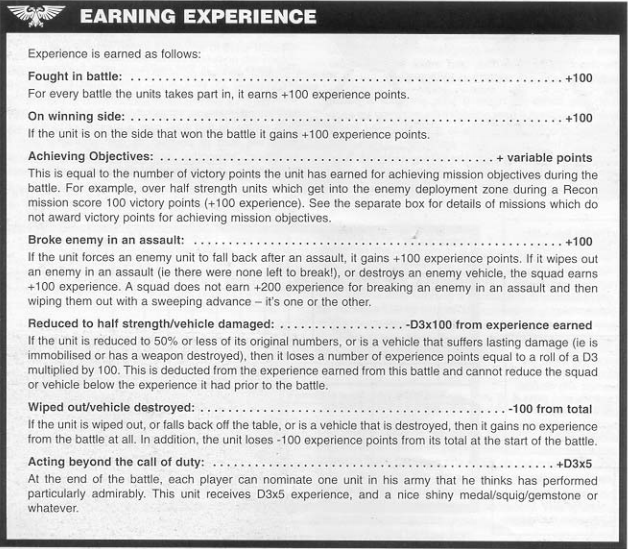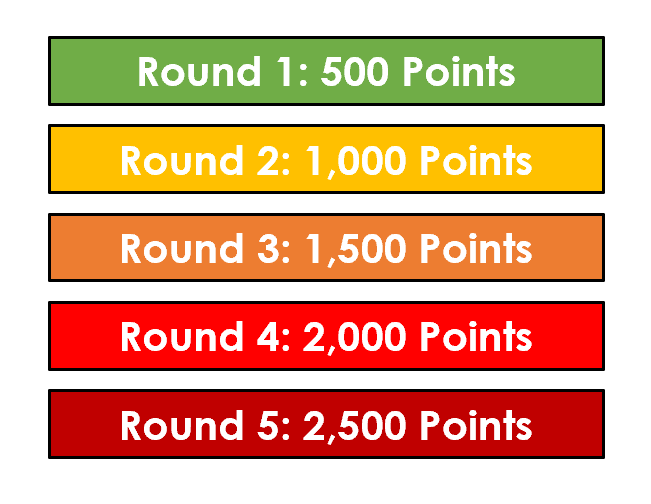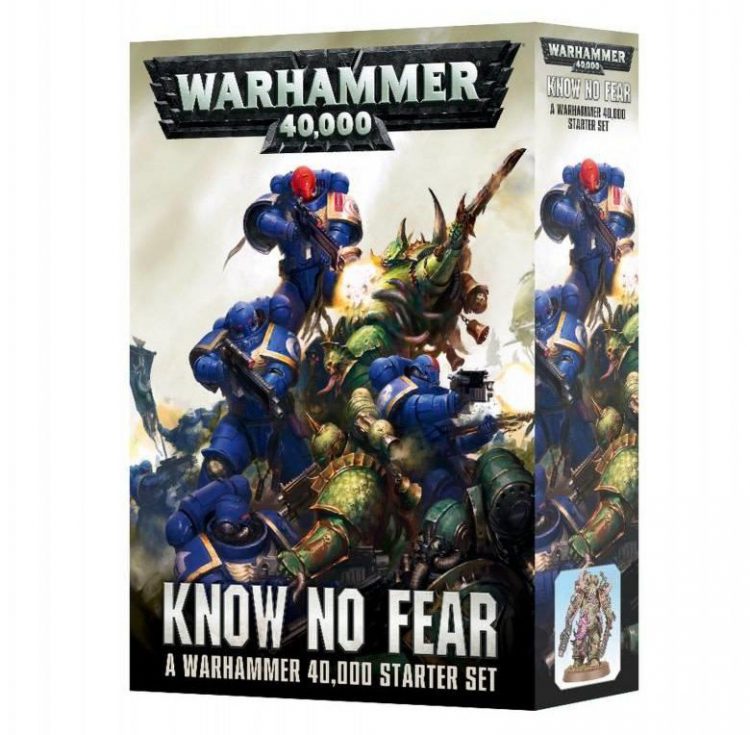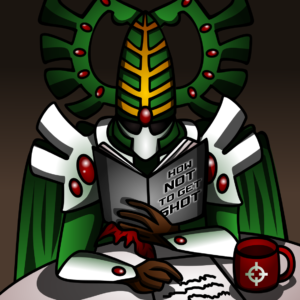The Warhammer 40,000 universe is a massive place, and the “Narrative Forge” hobby articles encourage thinking outside the box (literally) when putting models together and stretching yourself out in the hobby. They aim to make hobbyists and players comfortable growing beyond imitating the models they see in their Codexes and playing the rulebook missions, and serve as a source of inspiration for anyone wanting to forge new experiences in the hobby. This week, Robert “TheChirurgeon” Jones is continuing his multi-part series on creating and running campaigns. This week, he’s talking about Escalation Leagues
In our last article, we explored building and running a Mass campaign, with many players. Today we’ll be looking at a different type of campaign, and one you can easily layer on top of other, existing campaigns.
Escalation Campaigns/Leagues
Escalation Leagues/Campaigns, sometimes referred to as “slow grow campaigns,” have been around a long time and follow a pretty simple premise: Grow your forces as the campaign goes on, increasing the number of points/units players have access to each round. Depending on how they’re structured, the rules for this can either be simple, i.e. “this week you should be playing games of 1,500 points,” or complex, using set army rosters with experience point systems and rules around which units can be used. But the basic premise is that each round of the campaign, players are given a set points value for their games, and that value increases in subsequent rounds. So a campaign might see players starting with 500-point armies in round 1, then increasing that to 750 in round 2, 1,000 in round 3, 1,250 in round 4, and so on.
If you want to get more complex with how players expand their army rosters, you can do that, and we’ll talk about that more in detail later on.
Why Run an Escalation Campaign?
- You have several new players, or players starting new armies. Because the armies in Escalation campaigns start small and grow over time, they’re ideal for new players who are just starting with an army, or older players just starting a new army. Each round gives players an incentive to acquire, assemble, and paint new units to add to their force. If you like, you can start with strict guidelines on army construction, or let players bring whatever.
- You have a lot of players. Although you can overlay Escalation rules on top of other campaign structures, Escalation Leagues are pretty easy to manage with a large number of players (8 to 20). Whether you’ve got assigned games each round or players are free to schedule on their own, the core campaign rules can be as simple as “this is how many points you have to play with this round.”
- You want to encourage hobby progress. Escalation rules give players a lot of time and incentive to assemble and paint new models, giving them time to work on conversions and build up as they go. This is ideal if you want to encourage hobby progress in your group, or if you want to enforce a “play it painted” standard for the campaign without punishing players too much for having lots of gray plastic.
- You want to mix things up with the games. Starting small and moving to bigger games gives you a lot of ways to encourage different types of play. At smaller levels, players will have to rely more on Troop choices and other more basic options before expanding to more complicated forces later on. Some armies or factions that may struggle at 2,000 points may actually be very strong at lower levels (Necrons immediately come to mind), and players may enjoy how the experiences vary as the campaign goes on.
- You don’t want to spend a ton of time on the story elements. You can certainly include a major story in your escalation campaign, but you can also go as light as you like in that regard, making Escalation leagues great for when you have lots of players who want to play connected games, but don’t have a ton of time to spend crafting a detailed narrative. Just have players track wins and losses, and use that to determine a winner at the end.
Consider an Escalation Campaign if: You have a lot of new players or people starting new armies. Just leave out the extra bells and whistles and focus on letting players build their armies. It’s a great way to give players regular hobby goals while acclimating them to Warhammer 40,000 and getting them up to speed on the rules and how campaigns might work. Or if you have a lot of players and want to have an easy-to-execute campaign concept without spending a ton of time on campaign mechanics or story elements. Or layer it into your existing campaign to add an additional narrative wrinkle, to represent forces growing over time as generals amass power and conquer territory, leading up to a climactic showdown with the fate of the planet at stake.
Building Your Own Escalation Campaign
There aren’t a ton of readily-available resources on running an Escalation Campaign, but as a format, they’re pretty straightforward. When I ran the Astradus Campaign I started earlier this year, I included an escalation element, starting at 750 points per army and going to 1,000, then 1,500, and then finally to 2,000 points. When you plan your Escalation campaign, you need to answer the following questions:
- What points value do I want to start at? Note that while generally you can start as low as you want, I find that 40k is really not balanced well below 1,500 points and so you may want to limit the number of rounds you play did at sub-1,500 values. I recommend starting with 500 points at the lowest. Also note that at lower levels, you can have players play team games, so they can still get larger game experiences and worry less about the brutal impact of say, an Imperial knight showing up in a small game where players might not have the resources to deal with it.
- How should points increase with each round? You want your points to increase enough to have each round feel like a significant increase, but not so much that players struggle to model and paint that amount to add to their armies. Increments of 250 or 500 points work best for this.
- How long should each round last? This is up to you, but I recommend at least two weeks if your plan is to give players time to schedule games and add to their armies. You can use shorter rounds early on, as games will generally take much less time to play at 500 and 750 points, and you’ll need longer times for later rounds, where the time investment for individual games will become more significant.
- How many rounds will there be? Eventually you’ll hit 2,000 points in your campaign and while you can go higher than that, games will get unwieldy pretty fast if you aren’t using Apocalypse rules to handle them. I recommend limiting the number of 2,000-point rounds you play and ending the campaign where it makes sense to declare a winner.
- How will you score it? You’ll want a system for scoring players for wins. It can be a simple 2 points for a win, 1 point for a tie system, or 3 win/2 tie/1 loss to encourage playing, or you can give players winners for completing rounds, or even award points for hobby progress.
- How will army construction be handled? Can players bring whatever they want, or do they have to grow from a set base set of models or units? Both formats have their ups and downs, which we’ll discuss below.
Also note that at smaller points values you should consider using the Matched Play guidelines for smaller games, i.e. limiting players to a maximum of 2 non-Troop duplicate datasheets per army and playing on 4×4′ tables at points values of 1,000 or below. This will help ensure more balanced games and keep games tight.
Add-ons and Extra Rules
If you want to do something more complicated than just “players play games, and they can bring more points each round, then you can always layer additional campaign elements or rules on top of your escalation campaign. Or layer an escalation progression onto your existing campaign. As you build, here are a few add-on rules and systems you might want to consider to spice things up:
- Themed Rounds – One way to add some variety to your Escalation campaign is to give each round a theme. These can be really good if your players are building and adding to their armies with new models as they go, because you can use themes to encourage them to add specific unit types. One week might have a heavy support theme, while another might have a flyers theme. Or one week might use missions that encourage a specific unit type instead. That can help you influence the decision without guiding it. Because Escalation campaigns can often focus on or reward players purchasing new models, they’re ideal for game stores to run as campaigns (the the most frequent type I see stores running). Even the recent Fate of Konor campaign run by Games Workshop had a model/army construction theme in it that encouraged buying new models and adding them to your campaign army.
- Hobby Points and Bonuses – Likewise, if you’re encouraging players to add to their armies during the course of the campaign, you can also encourage them to paint and model new additions. This can also be a great way to reward players for participation if they aren’t winning games, by allowing them to catch up a bit with their hobby progress. And it also encourages great-looking armies
- Battlezones – In a similar vein, you could apply specific Battlezones to each round, to represent a new territory, area, or planet being fought over and creating adverse conditions for players’ armies. Have a quick pass through the game’s battlezones or make your own and use them to give each round a specific twist.
- Mass Campaign Elements – Escalation campaigns work well with lots of players, and they work well as add-ons for a mass campaign. There’s no reason you can’t combine the two to make something bigger for your players.
- Fixed Roster Construction – If you want to get particularly complicated, you can create a fixed roster system, where once a unit has been added to a player’s campaign army, they have to continue to take it. This has its ups and downs. On the one hand, it can be good for “leveling the playing field” for new players who have limited resources or time and can’t keep up with a player who may have the ability to buy and paint a ton of units every week, giving them a bigger pool to choose from. On the other hand, if someone adds a unit and doesn’t like what it does for their army, they risk being “stuck” with a bad choice, so you may want to have some leniency for this. Anyways, the way this works is you have players register their armies and then as they add to it, those new units become part of a larger “army pool” that players can pick from when building their armies (generally you should just make this about units and not wargear choices, since players may need to fiddle around with those to get to the right points levels). So as an example, I may have players start with 500 point armies, then for phase 2, they can add an additional 500 points, but we’ll only increase army size to 750. Whatever they add to their rosters in that extra 500, they have to stick with, but they can pull any units to make a 750-point list out of their pool of 1,000 points. This also gives you a way to differentiate later rounds — once you’ve gotten to 2,000 points, you can start with 2,000 as your pool size, then go up for another round or two, giving players more flexibility without increasing the points value of games to unwieldy numbers.

- Experience Systems – If you want to add a lot of depth very quickly, you can create or tack on a system for gaining XP and spending it on upgrades and key wargear assets. 40k and Fantasy both used to have rules for this, and experience systems tend to work best with fixed roster construction (see above). What you’ll be doing here is assigning XP to units in a fixed roster for participating in and maybe accomplishing certain things in a game, and allowing players to buy upgrades for units that have accumulated certain amounts of XP, typically called Battle Honuors. Last year’s Chapter Approved 2018 has a great experience system you can add to your games and we’ll talk about leveling and experience systems in more detail in a future Narrative Forge. These can be great ways to keep players invested in the success of individual units and tell interesting stories throughout the campaign, as one of their units accumulates multiple accolades and distinguishes itself time and time again. But watch out — these also work best for smaller armies; at higher points values, tracking a dozen units’ worth of XP and upgrades can get very time-consuming, and isn’t something every player will want to do. You also run the risk of players creating degenerate combos with your custom skills and experience bonuses. My advice here is to have players submit everything that they create with these systems for a quick review. I like to tell my players: “Don’t create anything that’s going to force me to have to post a group note on the meaning of sportsmanship.”
One_Wing’s Notes on Running an Escalation League
What worked:
- Hobby points: The league awarded points for adding new units to your army in each phase, and some extra points in the final phase for having a complete army. While I’ll be making some changes to how these were allocated (as we’ll see in a second) including these was a good call. You want to do your level best to avoid people falling behind the curve of painting new units and having the final phase be full of grey plastic armies would be a very disheartening way for the league to end.
- Themed phases: I didn’t have long to write the pack last time, but came up with a basic narrative theme for each round, picked missions out of the Rulebook and Chapter Approved that aligned with them, and then added a “twist” to each phase
- Scoring: Players could earn up to 3 hobby points per phase, and then add in scores from their first two games in the phase on a sliding scale based on victory margin. There was some additional complexity, but the system held together extremely well and the scores ended up pretty close, leading to a genuinely tense last few weeks.
What I’ll improve:
- Army building and gameplay were quite “detached”: This time around, with more time to work on it, I’ll be including phase themes, mission special rules and hobby points that players can tie directly in to the units they’re adding to their army, hopefully making everything feel more “joined up”.
- Hobby points/cash money: The original scoring rubric awarded a point each for a newly painted unit and a newly painted character per phase. This was both quite tough on the wallet and didn’t always make sense for every army to do. This time around I’ll instead be tying the second point to the phase theme, so one point for adding a unit and one point if that unit meets a qualification that will change each round. I may also substitute in other hobby activities that are less draining on the wallet than buying new plastic for some phases, especially if I can’t think of good themes for unit addition.
- Think more outside the box: Last year the rules I wrote crashed hard into some themed armies that people wanted to build, and some last minute bodge fixes had to be added after the pack went to print. While I still don’t think I’ll be supporting pure Knight armies very well, I’ve got new rules lined up to support other themed forces without breaking the game. I’m also planning to custom write some missions to allow me to go a bit more to town on theme in some phases, and add in some alternatives for people who can’t make the time for two full games in the larger phases.
I’m very excited to bring all of what I’ve learnt together and hopefully the new league, in which I will be painting up a Space Marine army like the terrible tryhard I am, will be an even bigger success than before!
Next Time: Battlezones
That wraps up our look at Escalation campaigns. Next time we’ll take another detour from our series on campaigns to talk about Battlezones, which represent battlefield conditions or hazardous settings you can apply to missions to make them stand out a bit more. As always, if you have any questions, comments, or feedback, we’d love to hear it! Drop us a note in the comments below, ore mail us at contact@goonhammer.com.





